Farmer's Welfare
Empowering Indian Farmers
Posted On: 07 JUN 2025 10:06AM
|
“Increasing the income of the farmers, reducing the cost of farming, providing modern facilities to the farmers from seed to market is the priority of our government.”
- Prime Minister Narendra Modi
|
Introduction
Agriculture is at the heart of India’s economy and culture, sustaining millions and shaping the nation’s identity. Over the past eleven years, under Prime Minister Narendra Modi’s leadership, India’s agricultural sector has undergone a profound transformation, rooted in the philosophy of Beej Se Bazaar Tak (seed to market).
This transformation champions inclusivity, supporting small farmers, women-led groups, and allied sectors, while making India a global agricultural leader. The farmer has become central to policy, with a proactive, technology-driven approach ensuring income security, sustainability, and resilience.
From modern irrigation and credit access to digital marketplaces and agri-tech innovations, India is embracing smart farming and reviving traditional practices like millet cultivation and natural farming. Allied sectors such as dairy and fisheries are also flourishing, driving rural prosperity and climate-smart agriculture.
Above all, the mindset has shifted, Farmers are now recognised as key stakeholders and drivers of India’s growth. As India enters Amrit Kaal, its empowered farmers stand ready to lead the nation from food security to global food leadership.
Enhanced Budget Allocation
Agriculture serves as the backbone of India's economy, playing a pivotal role in ensuring food security, providing employment, and contributing to overall economic development. It supports the livelihoods of a significant portion of the population and remains vital to India's socio-economic fabric. Recognizing its importance, the Government of India has implemented various initiatives and significantly increased budget allocations to strengthen the sector.
The Budget Estimates for the Department of Agriculture and Farmers’ Welfare have seen remarkable growth, rising from ₹27,663 crore in 2013–14 to ₹1,37,664.35 crore in 2024–25, an increase of nearly five times over the period.
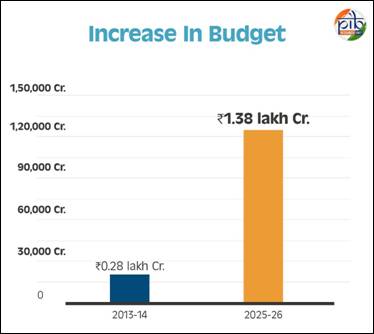
This substantial increase in budget allocation has played a pivotal role in transforming the agricultural sector, enabling greater investment in infrastructure, modernization of farming practices, expansion of support schemes, and enhanced income security for farmers across the country.
Increased Food Grain Production
India’s foodgrain production grew steadily from 265.05 million tonnes in 2014–15 to an estimated 347.44 million tonnes in 2024–25, showing a strong rise in agricultural output.
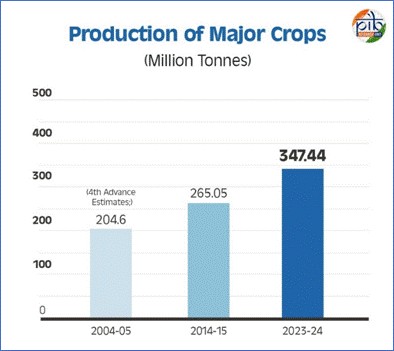
|
The major crops include rice, wheat, jowar, bajra, maize, ragi, barley, gram, tur, pulses, groundnut, soybean, rapeseed & mustard, oilseeds, sugarcane, cotton, and jute & mesta.
|
Increase in MSP and Support for Farmers
During the period 2014-15 to 2024-25, procurement of 14 Kharif crops was 7871 LMT while during the period 2004-05 to 2013-14, procurement was 4679 LMT.

Wheat MSP Growth and Record Procurement
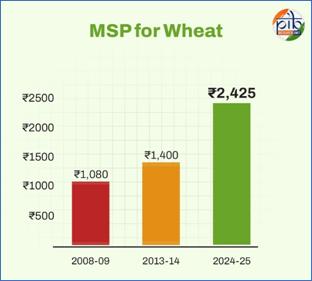
The MSP for wheat rose from ₹1,400 per quintal in 2013–14 to ₹2,425 per quintal in 2024–25, ensuring better returns for wheat growers. A total of ₹6.04 lakh crore has been disbursed as MSP payments for wheat during 2014–2024, a substantial rise compared to ₹2.2 lakh crore paid during 2004–2014.
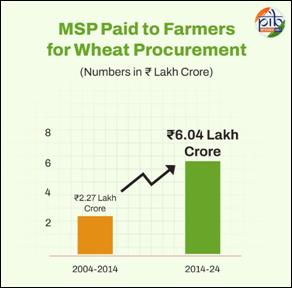
Paddy MSP Growth and Record Procurement
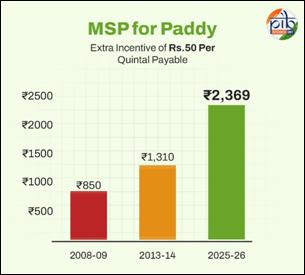
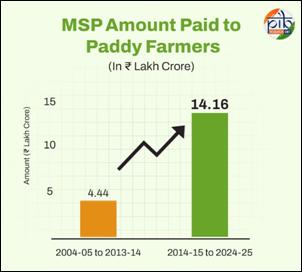
The MSP for paddy increased from ₹1,310 per quintal in 2013–14 to ₹2,369 per quintal in 2025–26, benefiting millions of paddy farmers. During the period 2014-15 to 2024-25, procurement of paddy was 7608 LMT while during the period 2004-05 to 2013-14, procurement of paddy was 4590 LMT. During the period 2014-15 to 2024-25, MSP amount paid to Paddy growing famers was Rs. 14.16 Lakh Crore while during the period 2004-05 to 2013-14, amount paid to farmers was Rs. 4.44 Lakh Crore.
MSP for Grade-A paddy increased from ₹1,345 per quintal in 2013–14 to ₹2,389 per quintal in 2025–26
Pulses
Over the past eleven years, the government has brought a significant turnaround in the pulses sector. Previously marked by low cultivation, limited procurement, high import dependence, and elevated consumer prices, the sector now exhibits increased cultivation, substantial procurement driven by higher MSPs, reduced import reliance, and improved price stability for consumers.
Procurement of pulses at Minimum Support Price (MSP) witnessed a significant increase of 7,350%, rising from 1.52 lakh metric tonnes (LMT) during 2009–2014 to 82.98 LMT during 2020–2025.
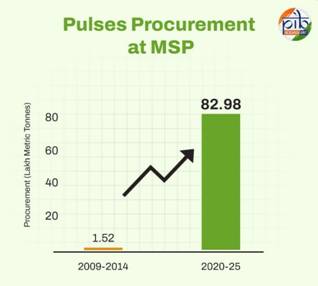
Oilseeds procurement at MSP increased by over 1,500% in the last eleven years, reflecting the government's strong support for oilseed farmers.
Minimum Support Prices for all Kharif crops for Marketing Season 2025-26
|
S.No.
|
Crop
|
MSP 2013-14 (₹/quintal)
|
MSP 2025-26 (₹/quintal)
|
% Growth from 2013-14
|
|
1
|
Paddy (Common)
|
1310
|
2369
|
81%
|
|
2
|
Paddy (Grade A)
|
1345
|
2389
|
78%
|
|
3
|
Jowar (Hybrid)
|
1500
|
3699
|
147%
|
|
4
|
Jowar (Maldandi)
|
1520
|
3749
|
147%
|
|
5
|
Bajra
|
1250
|
2775
|
122%
|
|
6
|
Ragi
|
1500
|
4886
|
226%
|
|
7
|
Maize
|
1310
|
2400
|
83%
|
|
8
|
Tur / Arhar
|
4300
|
8000
|
86%
|
|
9
|
Moong
|
4500
|
8768
|
95%
|
|
10
|
Urad
|
4300
|
7800
|
81%
|
|
11
|
Groundnut
|
4000
|
7263
|
82%
|
|
12
|
Sunflower Seed
|
3700
|
7721
|
109%
|
|
13
|
Soybean (Yellow)
|
2560
|
5328
|
108%
|
|
14
|
Sesamum
|
4500
|
9846
|
119%
|
|
15
|
Nigerseed
|
3500
|
9537
|
172%
|
|
16
|
Cotton (Medium Staple)
|
3700
|
7710
|
108%
|
|
17
|
Cotton (Long Staple)
|
4000
|
8110
|
103%
|
Financial Security for Farmers
PM-Kisan Samman Nidhi
- As of now over ₹3.7 lakh crore transferred to more than 11 crore farmers.
- A farmer-centric digital infrastructure ensures the transparent & direct delivery of benefits to farmers nationwide, eliminating middlemen.
|
The PM-KISAN scheme, a central sector scheme launched in February 2019, aims to supplement the financial needs of land-holding farmers. It provides ₹6,000 per year in three equal instalments directly into Aadhaar-seeded bank accounts through Direct Benefit Transfer (DBT), ensures timely assistance for small and marginal farmers to invest in quality inputs and increase yield.
Kisan Credit Card (KCC)
- As of now ₹10 lakh crore credit provided to 7.71 crore farmers.
- Loan limit under KCC enhanced from ₹3 lakh to ₹5 lakh for 2025–26.
|
The Kisan Credit Card (KCC) Scheme ensures hassle-free and affordable credit to farmers for short- and long-term cultivation, post-harvest expenses, and consumption needs. It provides easy access to credit for agriculture and allied sectors, supporting farmers' financial stability.
Reducing Risk and Increasing Resilience
Pradhan Mantri Fasal Bima Yojana
Pradhan Mantri Fasal Bima Yojana (PMFBY), launched in 2016, aims to provide a simple, affordable, and comprehensive crop insurance product to Indian farmers. This scheme covers all non-preventable
- As of now 63.23 crore farmer applications enrolled under the scheme.
- Over 19.91 crore farmers (provisional) received insurance claims.
- ₹1.75 lakh crore(provisional) paid out in claims to farmers.
|
natural risks from pre-sowing to post-harvest, ensuring financial support in the event of crop failure due to natural calamities, pests, or diseases.
Following the "One Nation, One Crop, One Premium" principle, PMFBY offers a comprehensive shield against crop losses caused by unpredictable natural hazards. This protection not only stabilizes farmers' income but also encourages them to adopt innovative practices.
Pradhan Mantri Krishi Sinchayee Yojana
- As of now ₹93,000+ crore allocated for 2021–26.
- 112 irrigation projects implemented, reducing dependence on monsoons.
|
Pradhan Mantri Krishi Sinchai Yojana (PMKSY) was launched during the year 2015-16, with an aim to enhance physical access of water on farm and expand cultivable area under assured irrigation, improved on-farm water use efficiency, introduce sustainable water conservation practices, etc.
Soil Health Cards
Soil Health and Fertility Scheme has been implemented by the Government since 2014-15. Soil health card provides information to farmers on nutrient status of their soil along with recommendation on appropriate dosage of nutrients to be applied for improving soil health and its fertility.
|
Achievements under the Soil Health Card Scheme (as of now):
- 1.75 crore Soil Health Cards (SHCs) generated across the country.
- ₹1,706.18 crore released to States/UTs for implementation.
- 8,272 Soil Testing Labs established nationwide
|
Modern Infrastructure for Agriculture
Agriculture Infrastructure Fund (AIF)
Launched in 2020-21, the Agriculture Infrastructure Fund (AIF) is a key initiative aimed at bridging critical gaps in post-harvest management by supporting the development of farm gate storage, logistics, and processing infrastructure. The scheme promotes the establishment of facilities such as warehouses, cold storage units, grading, and processing centres, thereby enhancing farmers’ direct access to markets and helping to increase their income. With a total outlay of ₹1 lakh crore, the fund supports the creation of post-harvest and community farm assets, and is operational for a period of 13 years from 2020–21 to 2032–33.
|
Achievements under Agriculture Infrastructure Fund (AIF) in FY 2024-25:
- ₹21,379 crore sanctioned for 42,864 projects.
- Out of this, ₹14,284 crore covered under scheme benefits.
- Major projects sanctioned under AIF include 12,550 Custom Hiring Centres, 8,015 Processing Units, 2,765 Warehouses, 843 Sorting & Grading Units, 668 Cold Storage Projects, and around 18,023 Post-Harvest Management & Viable Farming Asset Projects.
|
PM Kisan Samriddhi Kendras
Pradhan Mantri Kisan Samriddhi Kendras serve as one-stop centres providing seeds, fertilizers, tools, and timely information on farming and government schemes, making agriculture more convenient and informed for farmers.
- 1.8 lakh Kendras established as one-stop shops offering inputs and information to farmers.
|
e-NAM & Market Reforms
- 1,473 mandis integrated with e-NAM across 23 States and 4 Union Territories
As of December 2024:
-
- 1.79 crore farmers registered
- 2.59 lakh traders registered
Total trade recorded:
- 11.02 crore metric tonnes of commodities
- 36.39 crore units (bamboo, betel leaves, coconut, lemon & sweet corn)
Total trade value: ₹4.01 lakh crore
|
National Agriculture Market (eNAM), a pan-India electronic trading portal, networks the existing Agriculture Produce Market Committee (APMC) mandis to create a unified national market for agricultural commodities. The initiative was launched by Prime Minister Narendra Modi on April 14, 2016. e-NAM platform promotes better marketing opportunities for the farmers to sell their produce through online competitive and transparent price discovery system and online payment facility. The e-NAM portal provides single window services for all APMC related information and services. This includes commodity arrivals, quality & prices, buy & sell offers and e-payment settlement directly into farmers’ account, among other services.
Mega Food Parks
|
Mega Food Parks increased from 2 in 2014 to 41 in 2025 under the Mega Food Park Scheme; 24 are operational and 17 under implementation, strengthening farm-to-market infrastructure.
|
The Mega Food Park Scheme links agricultural production to markets by connecting farmers, processors, and retailers, aiming to increase value addition, reduce wastage, and boost farmers’ income. Based on a cluster approach, it provides modern infrastructure like collection centers, processing units, cold chains, and industrial plots to promote food processing and rural employment.
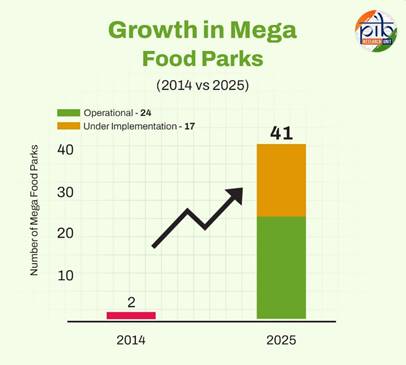
Innovation & Entrepreneurship in Agriculture
NAMO Drone Didi
Namo Drone Didi is a central sector scheme aiming to empower women-led Self-Help Groups (SHGs) by equipping them with drone technology to provide agricultural services. The scheme aims to provide drones to 15000 selected Women SHGs during the period from 2024-25 to 2025-2026 for providing rental services to farmers for agriculture purpose (application of liquid fertilizers and pesticides for the present). This initiative is expected to generate an additional income of at least Rs. 1 lakh per year for each SHG, contributing to economic empowerment and sustainable livelihood generation.
|
Over 7,000 agri and allied startups have been registered, marking a new era of innovation and entrepreneurship in India's agricultural sector.
1,943 agri-startups have received financial and technical support under the Rashtriya Krishi Vikas Yojana (RKVY) between FY 2019–20 and FY 2024–25
|
AgriSURE: Boosting Agri Innovation and Rural Entrepreneurship
In line with the Budget 2022–23 announcement, the Government of India and NABARD have launched AgriSURE (Agri Fund for Start-Ups & Rural Enterprises), a ₹750 crore Category-II Alternative Investment Fund (AIF) designed to power high-risk, high-impact agri start-ups.
With a focus on innovation, sustainability, and entrepreneurship across the agriculture value chain, AgriSURE provides equity and debt funding to ventures working on solutions such as FPO support, rental farm machinery, and IT-based agri-tech.
The Fund aims to:
- Create an investment-friendly ecosystem for agriculture and allied start-ups
- Enhance capital absorption capacity in rural enterprises
- Accelerate the growth of the agri-startup ecosystem
AgriSURE represents a bold step toward transforming Indian agriculture by empowering next-generation agri-entrepreneurs.
Diversifying Farmer Incomes
In addition to agriculture, diversification helps farmers manage risks, reduce dependency on unpredictable factors, and improve their standard of living. The government is promoting allied activities like livestock, dairy, fisheries, and food processing, along with non-farm employment, to create multiple income sources. These efforts not only enhance rural livelihoods but also contribute to the broader goal of structural transformation and economic development in rural India.
Food Processing Sector: A Key Driver of Farmers' Income Growth
Over the past eleven years, the food processing sector has emerged as a powerful enabler of farmers’ income enhancement. By creating robust farm-to-market linkages, reducing post-harvest losses, and expanding value addition through modern processing infrastructure, the sector has increased the profitability of agricultural produce. Government initiatives, particularly under the Pradhan Mantri Kisan Sampada Yojana, have driven exponential growth in processing capacity and exports, while also generating substantial off-farm employment, further supporting rural livelihoods
|
Key Achievements Supporting Farmers’ Income:
- Over 20-fold increase in food processing capacity: from 12 lakh metric tonnes (2013–14) to 242 lakh metric tonnes (2024–25), enabling greater value addition for farmers
- Processed food exports nearly doubled: from USD 4.9 billion (2013–14) to USD 9.03 billion tonnes (2024–25), expanding markets for farm produce
- Sector now contributes 12.41% of total employment in the organized manufacturing sector, offering alternative income sources for rural families
|
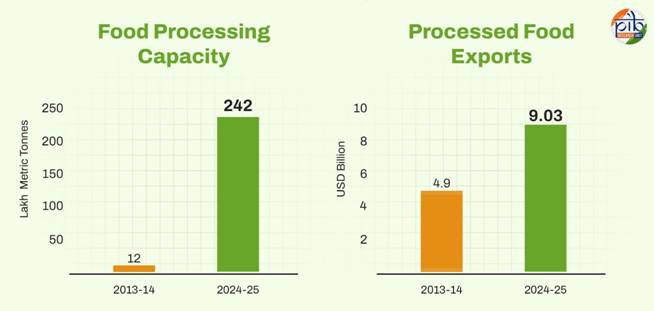
Blue Revolution
India is the second largest fish producing country with around 8% share in global fish production. Over the past two decades, India's fisheries sector has witnessed significant growth and transformation. From technological advancements to policy reforms, the period from 2014 to 2024 has been marked by milestones that have bolstered India's position in global fisheries and aquaculture. The Union Budget 2025-26, proposed the highest ever total annual budgetary support of Rs. 2,703.67 crores for the fisheries sector. To increase production and strengthen the sector, the Government created a dedicated Department of Fisheries.
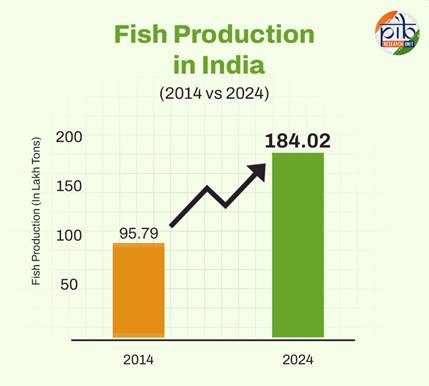
|
Achievements (2014-2024):
- Increase in Production: Fish production increased to an impressive 184.02 lakh tons (2023-24) from 95.79 lakh tons (2013-14) and 63.99 lakh tons (2003-04) registering an increase of 88.23 lakh tons in 10 years (2014-24) as compared to an increase of 31.80 lakh tons (2004-14).
- Increase in Inland and Aquaculture Fish Production: A tremendous increase of 77.71 lakh tons was achieved in Inland and Aquaculture fish production from 2014-24 as against the 26.78 lakh tons achieved from 2004-14.
- The marine fish production doubled to 10.52 lakh tons (2014-24) from 5.02 lakh tons (2004-14).
|
Dairy Sector
|
The sector has witnessed an average annual growth rate of 5.7%, significantly higher than the global average of 2%.
|
India ranks 1st in the world in milk production, contributing 25% of global output. Milk production in the country has increased by 63.56% over the last 10 years—from 146.3 million tonnes in 2014–15 to 239.2 million tonnes in 2023–24. Additionally, per capita milk availability in India has risen by 48%, reaching 471 grams/person/day in 2023–24, compared to the global average of 322 grams/person/day.
Dairying is a business for the world but in a vast country like India, it paves the way for employment generation, an alternative to strengthen the rural economy, provide solutions to the problems of malnutrition and women empowerment.
|
On March 19, 2025 Union Cabinet approved the Revised National Program for Dairy Development (NPDD) with a total outlay of ₹2,790 crore and the Revised Rashtriya Gokul Mission (RGM) with ₹3,400 crore for 2021–22 to 2025–26. These schemes aim to boost milk procurement, processing, and value addition, promote indigenous cattle breeding, strengthen the dairy supply chain, and enhance rural income and development.
|
|
Achievements (2014–15 to 2023–24):
-
- Milk production increased by 63.56%, from 146.3 MT to 239.3 MT.
- Indigenous cattle milk rose by 69.27%, from 29.48 MT to 49.90 MT.
- Buffalo milk increased by 39.73%, from 74.70 MT to 104.38 MT.
- Milking animals grew by 30.46%, from 85.66 million to 111.76 million.
- Over 8 crore farmers employed in the dairy sector.
|

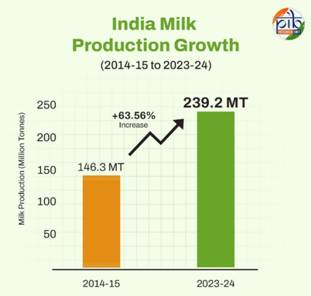
Sweet Revolution
The National Beekeeping and Honey Mission (NBHM) was launched in 2020 as part of the Atmanirbhar Bharat Abhiyan (Self-Reliant India Mission) with a total outlay of ₹500 crore for the period 2020–21 to 2022–23. The scheme has been extended for another three years, 2023–24 to 2025–26, with the remaining budget of ₹370 crore. It aims to promote the overall development of scientific beekeeping to achieve the vision of the "Sweet Revolution" and boost income generation and rural employment.
|
Export of honey tripled under Modi government.
|
Key Achievements of NBHM:
- India produced 1.42 lakh metric tonnes of honey in 2022–23 and exported 79,929 metric tonnes.
- 167 women SHG activities supported for empowerment.
- With growing demand for beekeeping centres, a minimum export price of USD 2,000 per metric tonne has been imposed up to 31.12.2025.
- 6 world-class and 47 mini honey testing labs, along with 6 disease labs, have been set up.
- 8 custom hiring centres, 26 honey processing units, and other infrastructure have been built.
- Madhukranti Portal launched for online registration and traceability – over 14,800 beekeepers and 22.39 lakh colonies registered.
- 7 of 100 FPOs (Farmer Producer Organizations) for beekeepers formed under TRIFED, NAFED, and NDDB.
Ethanol Procurement
Boost to Farmer Income through Ethanol Blending Programme
The Government of India is implementing the Ethanol Blended Petrol (EBP) Programme to promote the use of alternative, eco-friendly fuels and reduce dependency on imported crude oil. Under this programme, Oil Marketing Companies (OMCs) blend ethanol, produced mainly from sugarcane with petrol. The Government aims to achieve 20% ethanol blending in petrol by ESY 2025-26, advancing the original 2030 target. As of 28th February 2025, ethanol blending has reached 17.98%, progressing steadily from 10% achieved in June 2022. This initiative not only supports clean energy but also provides a steady income source to sugarcane farmers by creating sustained demand for ethanol. The increase in ethanol prices and separate payment of GST and transport charges further strengthen farmer earnings.
Key Achievements
- Ethanol procurement rose from 38 crore litres in 2013–14 to 441crore litres in 2023–24.
- Rs. 1,11,703 crores paid to sugarcane farmers in Sugar Season 2023–24.
- 3% price hike in C-Heavy Molasses (CHM) ethanol to ensure better returns for farmers.
- Separate GST and transport charges directly benefit farmers’ earnings.
|
The programme is a major step towards doubling farmers' income, reducing dependence on crude oil imports, saving foreign exchange, and protecting the environment.
|
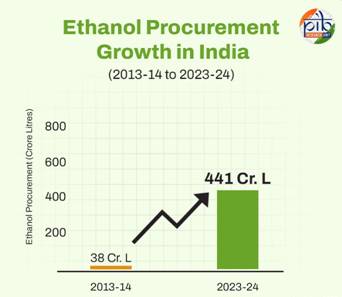
Solar Panels on Barren Land
The Pradhan Mantri Kisan Urja Suraksha evam Utthan Mahabhiyan (PM-KUSUM) aims to reduce diesel use in agriculture and boost farmer income. It offers 30–50% central subsidy for installing standalone solar pumps and solarizing existing ones. Farmers can also set up solar plants up to 2 MW on barren land and sell power to DISCOMs. The scheme promotes clean energy and income generation, and is implemented by state government departments.
|
Achievements under PM-KUSUM Scheme
- Solar Pumps for farmers see a growth of over 92 times.
- 49 lakh agricultural pumps to be solarised under the scheme.
- Supports clean energy, reduces diesel dependence, and boosts farmer income.
|
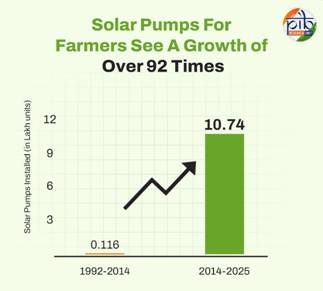
Towards Natural and Climate-Smart Agriculture
Paramparagat Krishi Vikas Yojana (PKVY)
The Paramparagat Krishi Vikas Yojana (PKVY) was launched in 2015–16 as the first comprehensive, centrally sponsored scheme for the promotion of organic farming in India. The scheme promotes organic farming through a cluster-based approach, encourages natural farming practices, and provides a digital platform for the direct marketing of organic produce. Additionally, the scheme includes the Large Area Certification (LAC) programme to certify traditionally organic regions, including tribal areas, islands, and hill regions. PKVY plays a crucial role in advancing sustainable agriculture, improving soil health, and enhancing farmers' income through organic practices.
Key Achievements under PKVY and LAC
Ø A total of ₹2,078.67 crore has been released under PKVY since its inception in 2015–16.
Ø 38,043 organic clusters (each covering 20 hectares) have been formed, with a total area of 8.41 lakh hectares brought under organic farming (including area under LAC).
Ø Under natural farming, an area of 4.09 lakh hectares across 8 states has been supported.
Ø Under the Namami Gange Programme, ₹272.85 crore has been released; 9,551 clusters have been formed, covering 1.91 lakh hectares.
Ø A dedicated online portal, www.jaivikkheti.in, has been launched to facilitate the direct sale of organic produce by farmers to consumers. So far, 6.23 lakh farmers have registered on the platform.
Ø Various state-specific brands have been developed for the marketing of organic produce under the scheme.
- Under the Large Area Certification (LAC) initiative:
- 14,445 hectares in Car Nicobar and Nancowry group of islands (A&N Islands) have been certified as organic.
- The entire 2,700 hectares of cultivable land in Lakshadweep has been certified as organic.
- ₹96.39 lakh has been released to the State Government of Sikkim for certifying 60,000 hectares.
- A proposal to certify 5,000 hectares from Ladakh has been received, with ₹11.475 lakh already released.
National Mission on Natural Farming (NMNF)
The National Mission on Natural Farming was launched on November 26, 2024. The mission aims to promote chemical-free farming among one crore farmers and establish 10,000 Bio-Input Resource Centers, with a financial outlay of ₹2184 crore.
|
As of now production rose from 15.99 million tonnes (2021–22) to 17.57 million tonnes (2023–24), making up 5.29% of total foodgrain output in 2023–24.
Procurement under MSP increased from 6.3 lakh tonnes (2021–22) to 12.55 lakh tonnes (2023–24).
|
Millets: Shree Anna
India is the largest producer of millets in the world, contributing 18.1% to global millet production and an impressive 38.4% to global pearl millet (bajra) output. Recognising the nutritional and environmental value of this ancient grain, the United Nations declared 2023 as the International Year of Millets.

Celebrated as "Shree Anna" in India to reflect its status as a superfood, millets are among the oldest crops cultivated by humans and are now being hailed as the crops of the future. As Prime Minister Narendra Modi aptly stated,
“Millets are good for the consumer, the cultivator, and the climate.”
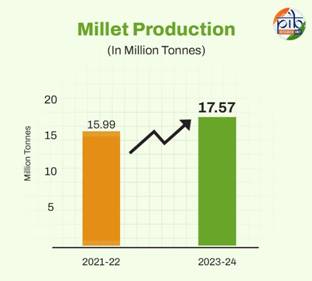
Seed to Market Reforms
Sub-Mission on Seeds and Planting Materials (SMSP)
|
₹100 crore allocated for the National Mission on High Yielding Seeds to boost research, develop high-yielding, pest-resistant, climate-resilient varieties, and ensure their widespread availability.
|
The Sub-Mission on Seeds and Planting Materials (SMSP), launched in 2014–15, aims to ensure the availability of quality seeds to farmers by promoting seed production, processing, storage, and certification across the country.
Key Achievements:
- 6.85 lakh Seed Villages created; 1649.26 lakh quintals of quality seeds produced; 2.85 crore farmers benefited.
- Created 13.70 lakh quintals of seed processing and 22.59 lakh quintals of storage capacity.
- 517 seed processing-cum-storage units established at Gram Panchayat level (2017–20).
- 29.68 lakh quintals of seed maintained under the National Seed Reserve.
- Support provided for 67 Seed Testing Labs, 14 DNA Fingerprinting Labs, 7 Seed Health Labs, and 42 Grow-Out Test Facilities to strengthen seed quality control.
- Seed availability rose from 351.77 lakh quintals (2014–15) to 508.60 lakh quintals (2023–24). The availability of certified and quality seeds rose to 531.51 lakh quintals for the year 2024-25.
- SATHI Portal launched for seed traceability, with 20 states already operational.
- Cotton Seed Price Control Order (2015) ensures fair pricing; 2024 prices fixed at ₹635 (BG-I) and ₹864 (BG-II) per packet.
- 2,593 agricultural and 638 horticultural crop varieties notified since 2014–15.

Prime Minister Dhan-Dhaanya Krishi Yojana Announced in Union Budget 2025-26
Announced in the Union Budget 2025-26, the Prime Minister Dhan-Dhaanya Krishi Yojana will be launched in 100 low-productivity districts in partnership with states. The programme aims to benefit 1.7 crore farmers by enhancing agricultural productivity, improving irrigation infrastructure, and facilitating access to both short-term and long-term credit.
This comprehensive, multi-sectoral initiative will also tackle under-employment in agriculture through skilling, technological interventions, investment, and by revitalising the rural economy.
|
Other Government Initiatives:
1. One District One Product (ODOP)
Promotes balanced regional development by identifying 1,240 products from 773 districts. Over 500 categories listed on ODOP GeM Bazaar to boost public procurement.
2. Makhana Board
To be set up in Bihar to strengthen makhana production, processing, and marketing. Farmers to be organised into FPOs and supported with training and access to government schemes.
|
Conclusion
Farmers are the backbone of India’s agriculture sector, providing sustenance to the nation. Progressive reforms, technological advancements, and strong government initiatives have driven significant growth and improved efficiency. The Modi government has introduced a comprehensive and future-ready approach, focusing on financial inclusion, climate-smart agriculture, and modern infrastructure to make farmers self-reliant, empowered, and prosperous. India’s journey from food security to farmer prosperity is well underway, rooted in vision, nurtured by action, and driven by the dreams of its Annadatas.
References:
Click here to download PDF
********
Explainer 06/ Series on 11 Years of Government
Santosh Kumar/ Ritu Kataria/ Anchal Patiyal
(Backgrounder ID: 154580)
Visitor Counter : 452
Read this release in:
Hindi